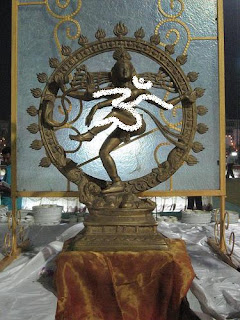"Tat tvam asi"
That thou art, or who we are, is possibly the most mysterious line ever. Our knowledge about the world, the universe, the people around definitely supersedes the knowledge we have about ourselves. Yes we know who we are on paper, our definition arises from how we have imagined ourselves to be, a part of a lineage, a caste/creed, a language/state, an occupation, by our achievements if any of credibility, or by a scandal. Today, this is how we define ourselves reducing the meaning of "Tat tvam asi" to just a profound noise which has no meaning in our lives, leave alone an impact.
So who am I really? Does the phrase "Tat tvam asi" have more meaning than what I am as a definition? Can the thought of "Tat tvam asi" transform my existing character into something more tangible and capable if i attempt to contemplate on it long hours to really figure out? The closest proximity we can feel with aatman is when we are able to hear the primordial sound OM within ourselves. If we block our ears and close all the other orifices, we come in touch with a faint vibration within ourselves. In fact while swimming when the ears are below water, its the perfect way to sense it. It mutes out all the other sounds and what remains is just a resonating sound within us. Its similar to the sound we can hear in a shell picked up from the sea shore. It just drives home the point that we have a source of sound within us and its not our vocal cords.
Here is the irony of the story. The scriptures, the sacred texts, the spiritual path, all of them indicate oneness with this sound. All indicate that we need to silence ourselves and try to listen to the powers within us and channelize them. In the earlier yugas, the external noise was far less, and communication was a profound levels. People didn’t need to talk much, the power of the word was so strong that once uttered it couldn't be taken back. Elitist languages like Sanskrit had multifold natures, its nature is not just to communicate but more to empower. They were single sentences but their value was tenfold purely for the limited usage.
And since communication was so limited, the need to communicate [like we do today] was not over used, the power of the word grew. Sound has been given a lot of value in Hinduism, from the sweetness of words falling into reality and being heard and imbibed as an experience of Ma Saraswati being seated on one's tongue purifying words as they roll out of a devotee's mouth to the pain being felt when one is rolled over the double edged sword of an angry rishi's curse. There was so much meaning to praises and curses in the previous yugas.
I just look at a day go by, with social media and television yelling out, there is enough noise to deafen our minds with the atrocities around us. The biggest difference between kali yuga and earlier yugas possibly was the lack of noise in earlier eras. Lack of noise directly translates to the power of sound. The unfortunate reality of these times is that there is so much noise that it has lost its value. But in our land of noise and din, where a moment's silence is hard to get, where a said word or promise doesn’t mean anything and can easily be broken, where responsible people take the path or lies and mislead people, where we have a crumbling society that stands on the grounds of deceit and indecency, where respect is defined by money power and not intellect... who am I now?
How can we explain the profound meaning of Tat Tvam Asi to our children in this age of madness, in this living hell?
The sure result of the damage excessive sound has made to the environment is in the reduced effect of it. Great mantras, once said delivered on the powers assigned to them, but in today's word, mere recital 108 times fetches no results. In the ancient times, bhava mattered, love and pure bhakti were easy to identify with and the resultant mantras bloomed within the person making them super human and God like, but today, with a lot of bhakti thrown in, and severe repetitions yields results, but it is slow, and leaves us wondering about the effects of its powers. People don’t have the patience to wait that long, and in an era of immediate results, we are destroying what was once a great faith that had the endurance to fight the effects of time. Today, that same belief is questioned and without a miracle, nothing will work anymore.

